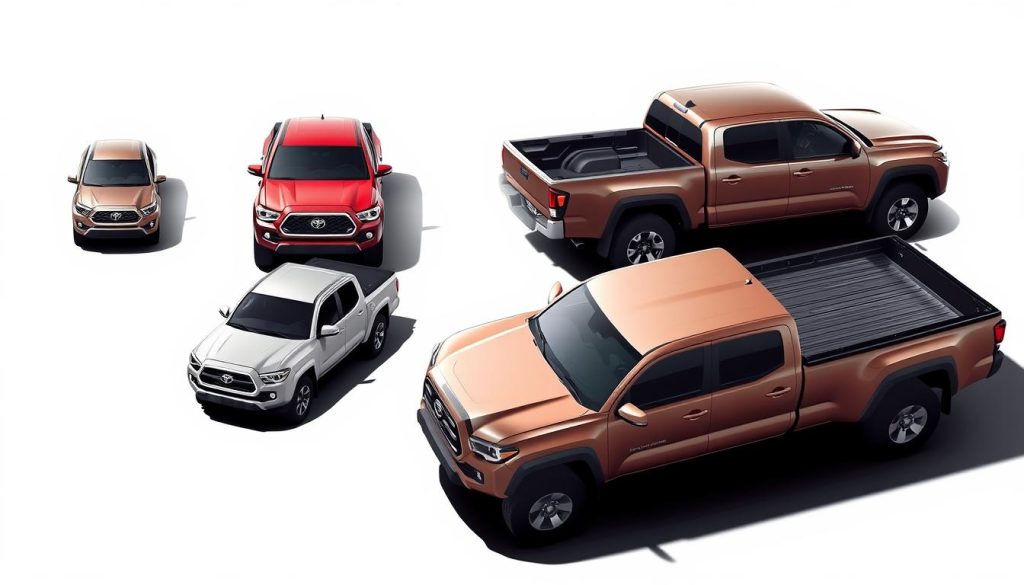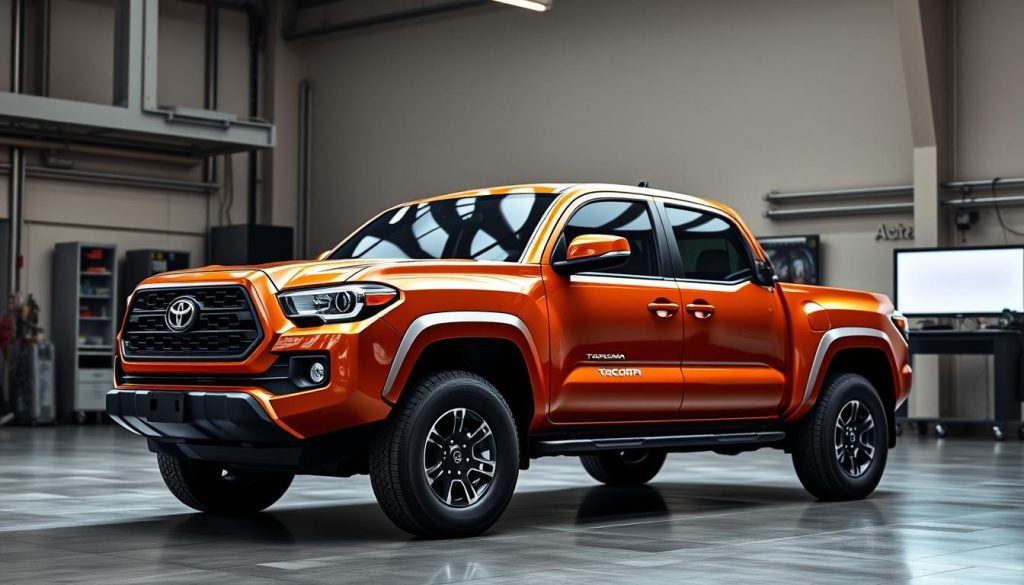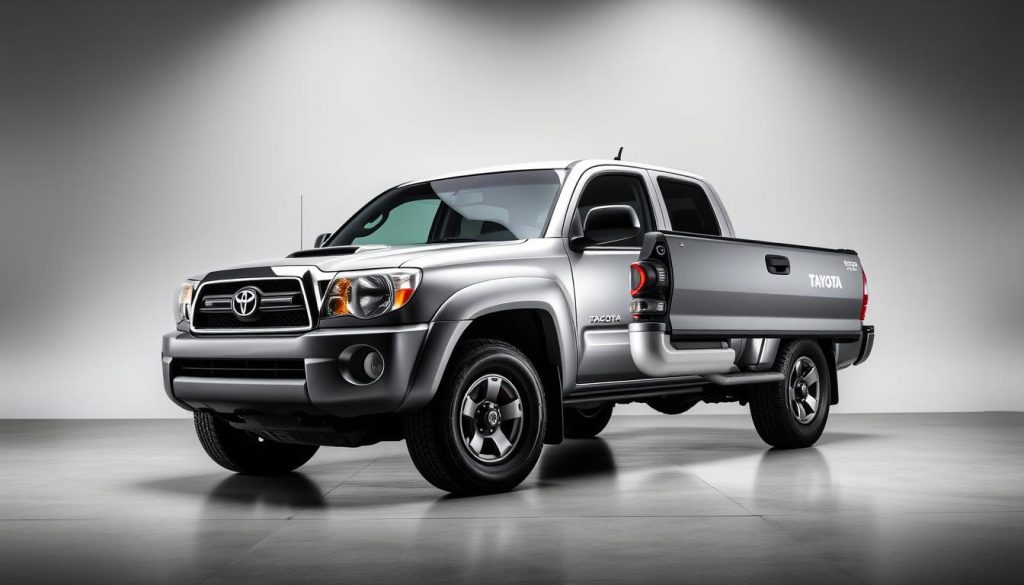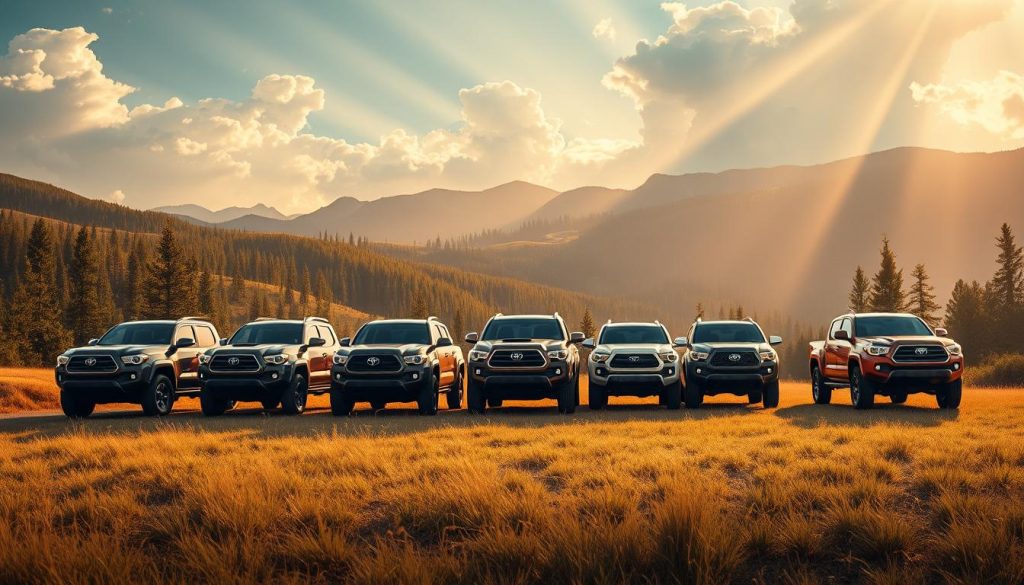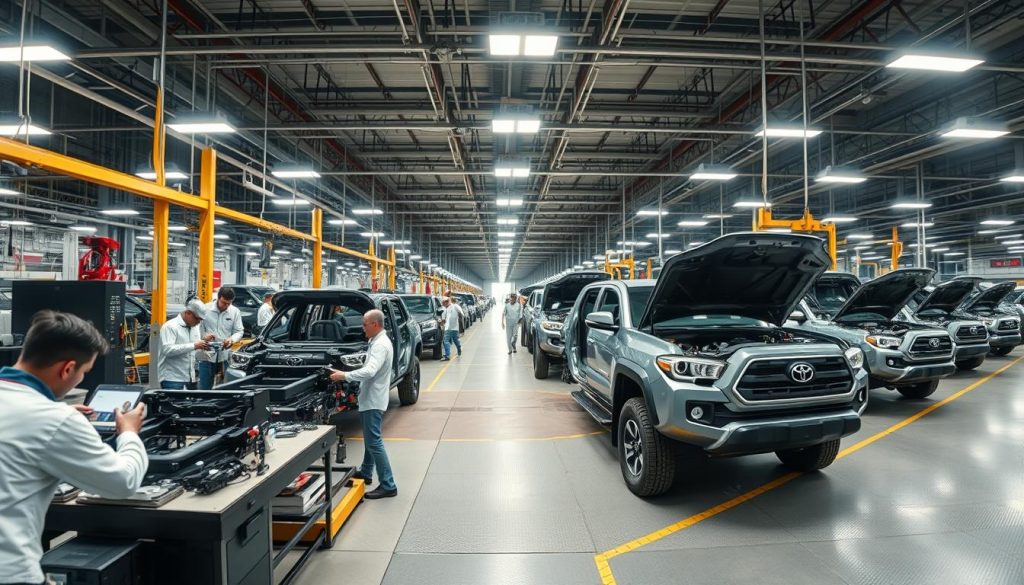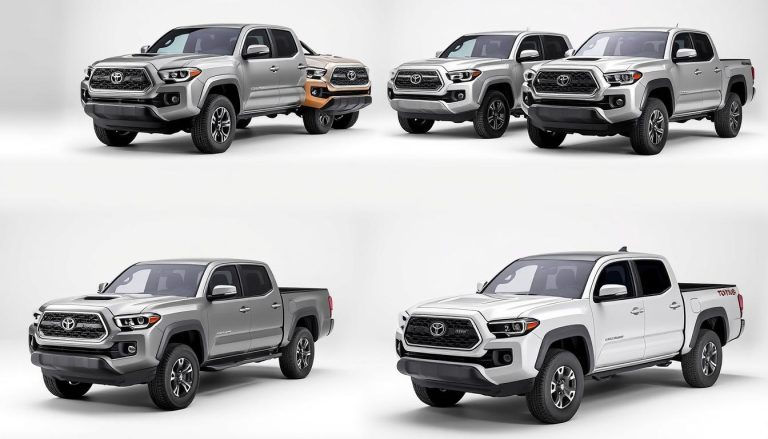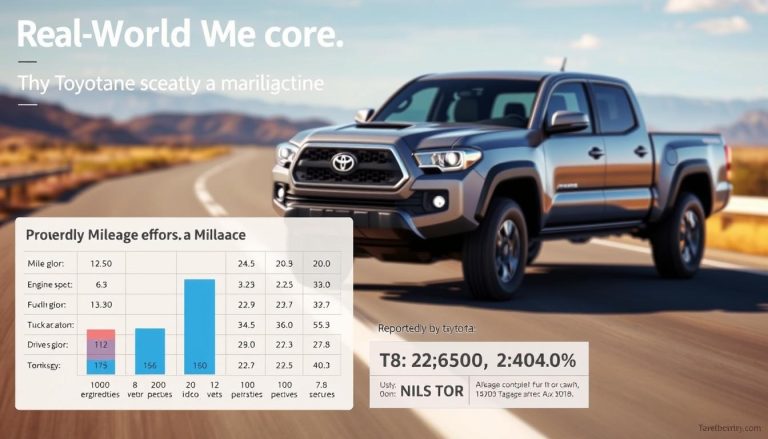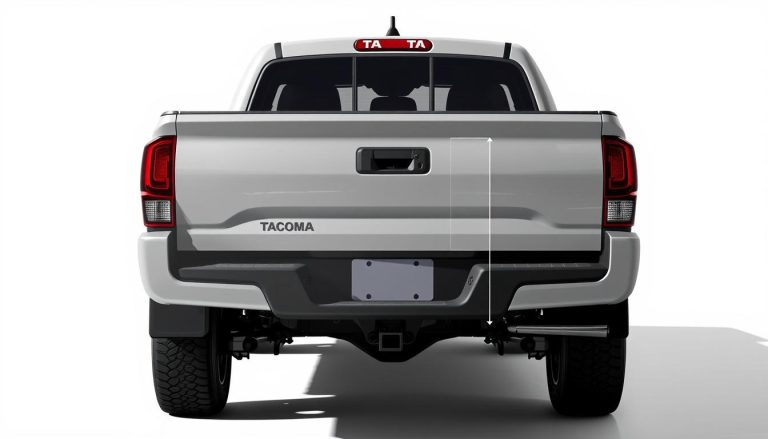Toyota Tacoma Model History: A Complete Timeline Guide
The Toyota Tacoma model history spans nearly three decades. It started in 1995 and has become a favorite among American drivers. They love it for its reliability and versatility.
The Japanese automaker made this truck to fill a gap in the compact pickup market. It was a smart move.
Looking at the Tacoma pickup evolution shows how Toyota turned a simple truck into a powerful mid-size vehicle. Over three generations, the truck got better in performance, comfort, and tech. These changes meet new consumer needs and higher car standards.
The truck’s growth from compact to mid-size shows Toyota’s commitment to the market. In 2005, it was named Motor Trend’s Truck of the Year. This award proved Toyota’s focus on quality and innovation.
Key Takeaways
- The Toyota Tacoma launched in 1995 as a compact pickup truck replacement
- Three major generations have evolved the truck from compact to mid-size classification
- Motor Trend awarded the Tacoma “Truck of the Year” honors in 2005
- Each generation brought significant improvements in performance and technology
- The truck consistently dominates the small pickup segment in America
- Toyota’s focus on reliability and durability defines the Tacoma’s reputation
Toyota’s Compact Truck Legacy Before the Tacoma Era (1964-1994)
Before the Tacoma became famous, Toyota worked for 30 years to build a strong base in the pickup market. Their journey was filled with innovation, engineering, and adapting to the market. This laid the groundwork for one of America’s favorite pickup trucks.
Toyota entered the North American truck market with big dreams and careful planning. They knew Americans needed reliable, efficient vehicles for work and daily use. This vision drove three decades of improvement and growth.
The Toyota Hilux Foundation and Global Success
The Toyota truck empire started in 1964 with the Toyota Stout in North America. It had an 86-horsepower engine and showed Toyota’s commitment to compact trucks. But the real change came in 1969 with the Toyota Hilux.
The Hilux was a game-changer worldwide. It was reliable, affordable, and versatile. Its strong build and good fuel economy showed Toyota’s skill in making tough vehicles that also saved gas.
Stories of success came from every continent. The Hilux excelled in the Australian outback and African markets. Its performance built Toyota’s global reputation. This feedback helped shape Toyota’s trucks for the North American market.
Toyota Pickup Truck Dominance in America
In North America, the Hilux was known as the Toyota Pickup. This name dominated the compact truck market for over 20 years. The name change showed Toyota’s understanding of American tastes and helped create a unique identity.
The Toyota Pickup’s success wasn’t by chance. It started well in all weather, saved gas, and needed little maintenance. These points were key as gas prices changed and people looked for smaller trucks.
The Toyota Pickup’s popularity grew in the 1970s and 1980s. It was reliable and made customers happy. This success made other truck makers rethink their strategies and improve their own trucks.
Building the Reputation for Unmatched Reliability
Toyota’s reputation for unmatched reliability was key to their truck success. The 22R engine, introduced in 1981, showed their dedication to durability. This engine was famous for lasting hundreds of thousands of miles with little upkeep, winning Toyota many fans.
The 1981 introduction of four-wheel drive was another big step. It changed the compact truck market and made competitors add all-wheel-drive systems. Toyota’s 4WD was reliable and capable, opening new markets for compact trucks.
Customers tested these trucks in real-world conditions. Workers, farmers, and outdoor lovers found Toyota trucks could take a lot of abuse. Stories of long-lasting Toyota trucks became famous, creating a loyal following.
| Year | Model | Key Innovation | Market Impact |
|---|---|---|---|
| 1964 | Toyota Stout | First compact truck entry | Established market presence |
| 1969 | Toyota Hilux/Pickup | Improved reliability design | Global success foundation |
| 1981 | Toyota Pickup | 22R engine introduction | Reliability reputation solidified |
| 1981 | Toyota Pickup 4WD | Four-wheel drive system | Market segment expansion |
By 1994, Toyota was the top name in compact truck reliability and innovation. Their careful engineering and listening to customers set the stage for the Toyota Tacoma. This journey of excellence would soon lead to the launch of a new truck that would carry on the best traditions and set new standards.
Birth of the Toyota Tacoma: 1995 Model Year Launch
When Toyota introduced the Tacoma in early 1995, it marked a big change. They stopped just rebadging global vehicles for the US market. Instead, they aimed to create a truck that fit North American tastes and driving needs.
This was more than just a new truck. It showed Toyota’s long-term commitment to the American truck market. They spent six years, starting in 1989, to make sure the Tacoma would meet American buyers’ needs.
Strategic Decision Behind the Tacoma Name
Toyota chose the “Tacoma” name to honor American culture. It comes from the Coast Salish peoples’ word for Mount Rainier in Washington State. This choice showed Toyota’s understanding of the importance of authentic American connections in trucks.
The Tacoma name was a big change from Toyota’s past. They wanted something distinctly American. The name connected the truck to the Pacific Northwest’s rugged beauty and outdoor lifestyle.
Initial Design Philosophy and Engineering Goals
Toyota aimed to make the Tacoma comfortable and easy to use daily. They knew American buyers used compact trucks as personal vehicles, not just work tools. This insight guided every part of the truck’s design.
The engineering goals focused on four key areas:
- Ride quality – Smoother highway performance than traditional work trucks
- Handling precision – Car-like maneuverability for urban driving
- Interior comfort – Enhanced ergonomics and materials quality
- Safety standards – Meeting stricter American crash requirements
These goals were a big change from Toyota’s past trucks. The team knew American buyers wanted versatility without sacrificing comfort.
Launch Specifications and Available Configurations
The 1995 Tacoma offered a wide range of options for buyers. Toyota provided different body styles to meet various needs. This showed the company’s commitment to serving many market segments.
Launch specifications included three engine choices:
- 2.4L four-cylinder engine – Economical option for light-duty use
- 2.7L four-cylinder engine – Balanced performance and efficiency
- 3.4L V6 engine – Maximum power for towing and hauling
Body style options included regular cab and Xtracab. Buyers could choose between 2WD and 4WD drivetrains. This variety made the Tacoma appealing to both city drivers and outdoor lovers.
The launch started a defining chapter in the Tacoma generations overview. Toyota’s careful planning and focus on the American market paid off right away. It set the stage for decades of success in the compact truck market.
First Generation Toyota Tacoma Deep Dive (1995-2004)
Toyota’s first Tacoma generation set new standards in the compact truck market from 1995 to 2004. This period showed Toyota’s serious commitment to the American pickup market. The Tacoma’s early years laid the groundwork for its future success.
Toyota aimed to create a truck that was practical for daily use and off-road capable. They knew American buyers wanted a versatile truck that was reliable. These early toyota tacoma redesigns paved the way for future innovations in compact trucks.
Compact Truck Market Positioning
The first Tacoma entered a competitive market led by the Ford Ranger and Chevrolet S-10. Toyota positioned the Tacoma as the premium choice in the compact truck segment. They focused on quality and reliability, not just the lowest price.
Research showed buyers valued durability over fancy features. Toyota built a truck that could handle daily driving and weekend adventures. The Tacoma’s reputation for unmatched dependability set it apart from competitors.
Sales figures showed Toyota’s strategy was successful. The Tacoma gained market share from established rivals. Toyota’s quality engineering proved that it could win over brand loyalty in the truck market.
Engine Options and Drivetrain Choices
Toyota offered three engine options to meet different customer needs. The base 2.4-liter 2RZ-FE four-cylinder had 142 horsepower and was fuel-efficient. It was perfect for those who valued efficiency over power.
The mid-level 2.7-liter 3RZ-FE four-cylinder had 150 horsepower and balanced fuel efficiency and performance. It was great for light towing and daily driving.
The top 3.4-liter 5VZ-FE V6 had 190 horsepower and serious towing capacity. It made the Tacoma a capable work truck. The V6 showed Toyota’s dedication to serving contractors and outdoor enthusiasts.
| Engine | Displacement | Horsepower | Primary Use |
|---|---|---|---|
| 2RZ-FE I4 | 2.4 Liters | 142 HP | Daily Commuting |
| 3RZ-FE I4 | 2.7 Liters | 150 HP | Balanced Performance |
| 5VZ-FE V6 | 3.4 Liters | 190 HP | Towing & Heavy Duty |
Regular Cab, Xtracab, and Bed Length Variations
Toyota offered two cab options to meet different needs. The Regular Cab was basic but had lots of bed space. It was great for contractors and fleet buyers who needed cargo space.
The Xtracab had more passenger space but the same bed length. It was better for recreational use and families. The Xtracab was more popular for these reasons.
Both cab types had the same 74.5-inch bed length. This made manufacturing easier and ensured consistent cargo space. It also made aftermarket accessories more compatible.
4×2 vs 4×4 Capability Differences
The Tacoma’s drivetrain choice greatly affected its character and capability. Two-wheel drive models had a five-stud wheel pattern and were more fuel-efficient. They were ideal for urban buyers who rarely faced tough terrain.
Four-wheel drive Tacomas had a distinctive six-stud wheel pattern and were off-road ready. The extra wheel studs provided strength for off-road use. This pattern was a clear sign of a truck’s capability.
4×4 models also had higher ground clearance and suspension tuning. These changes improved off-road angles and handling with heavy loads. The suspension made towing trailers easier.
PreRunner models offered a middle ground between 2WD and 4WD. They had the six-stud wheel pattern and higher ride height but without the 4×4 complexity. PreRunner models were appealing to those who wanted 4×4 looks and some capability without the extra cost and maintenance.
First Generation Mid-Cycle Updates and Improvements
Toyota showed its dedication to making things better with mid-cycle updates for the first Tacoma. These updates kept the truck up-to-date and met customer needs. The tacoma model years details show Toyota’s focus on making things better, a key part of their truck-making approach.
Between 1995 and 2004, Toyota made several updates. These changes were small and big, aiming to make the truck more appealing. They added new features and updated the look to reach more buyers.
1998 Model Year Styling Refresh
In October 1996, Toyota changed the Tacoma’s headlamps. They moved from recessed sealed beam headlamps to a flush design on 2WD models. This made the Tacoma look more modern and in line with current car designs.
Toyota then made two more updates. The first was in July 1997, and the second in October 2000. Each update brought subtle but meaningful improvements to the truck’s look.
These changes were more than just looks. They showed Toyota knew small updates could make a big difference in how customers saw the truck and how it competed in the market.
2001 Interior and Feature Enhancements
The 2001 Tacoma had big changes inside. Toyota made the interior more comfortable and convenient. This made the truck a better competitor in the market.
They also updated the dashboard for clearer displays and added new features. These changes showed Toyota’s commitment to continuous product evolution even within one generation.
The interior got better with ergonomic updates. These made controls easier to use. Toyota listened to customer feedback and real-world studies to make these changes.
PreRunner and Limited Edition Packages
The PreRunner model was introduced in 1998. It was a 2WD version with a 4WD look and feel. This was a smart move by Toyota to fill a market gap.
PreRunner buyers got the look and feel of a 4WD truck but with 2WD efficiency and lower cost. This was a unique offer that competitors missed.
In 2000, Toyota introduced the S-Runner, a performance-focused special edition. It had a sporty look and feel. This showed Toyota’s willingness to try new things for enthusiasts.
The success of these special editions proved Toyota’s strategy of catering to different customers. This made the Tacoma more appealing to a wider range of buyers.
Second Generation Complete Redesign (2005-2015)
Toyota introduced the redesigned Tacoma at the 2004 Chicago Auto Show. This marked a new chapter for America’s favorite mid-size pickup truck. Chikuo Kubota led the team for four years, working hard to transform the vehicle.
The result was a completely new truck, launched as a 2005 model on October 18, 2004. This generation offered buyers a wide range of choices. With eighteen different combinations, the toyota tacoma trims history reached a new milestone.
There were three cab styles, four transmission options, two powerful engines, and two bed lengths. This made the Tacoma more versatile than ever before.
All-New Platform and Chassis Development
Toyota engineers built the second-generation Tacoma from scratch. The new platform made the truck more rigid. This led to a better ride and less noise.
The new chassis used advanced materials and techniques. It made the truck more balanced and refined. This improvement kept the Tacoma’s legendary durability.
Expanded Engine Lineup and Transmission Options
Toyota revamped the engine options for 2005. The old 2.4-liter four-cylinder was replaced by an improved 2.7-liter four-cylinder engine. This engine offered better fuel economy and more torque.
The big addition was the new 4.0-liter V6 engine. It had more horsepower and torque than the old 3.4-liter unit. The V6 was perfect for those who needed maximum towing capacity and speed.
Transmission choices grew for both engines. Manual fans had 5-speed and 6-speed options. Automatic buyers could choose from 4-speed and 5-speed transmissions, depending on their engine.
| Engine | Power Output | Available Transmissions | Best Application |
|---|---|---|---|
| 2.7L 4-Cylinder | 159 HP / 180 lb-ft | 5-Speed Manual, 4-Speed Auto | Daily driving, fuel economy |
| 4.0L V6 | 236 HP / 266 lb-ft | 6-Speed Manual, 5-Speed Auto | Towing, performance, off-road |
| 4.0L V6 (Later years) | 245 HP / 282 lb-ft | 6-Speed Manual, 5-Speed Auto | Maximum capability |
Enhanced Safety Features and Crash Protection
Safety was a big focus for the second-generation Tacoma. Standard safety equipment was greatly expanded. Dual front airbags, side-impact door beams, and anti-lock braking systems were now standard.
The new platform’s crash structure improved occupant protection. Redesigned crumple zones absorbed impact energy better. These changes helped the Tacoma earn higher safety ratings.
Double Cab Introduction and Market Impact
The Double Cab configuration was a major addition to the Tacoma lineup. It offered four doors and comfortable rear seating for adults. The Double Cab had full-size doors and could seat five people.
The market loved the Double Cab. Families could now choose a Tacoma without giving up passenger space. But, the shorter bed length sparked debate among those who valued cargo space more.
Despite this, the Double Cab became very popular. Its success influenced the entire mid-size truck segment. Competitors were forced to create their own crew cab options.
Toyota Tacoma Model History: Defining Moments and Achievements
Toyota Tacoma history is filled with key moments. These moments show how smart choices and success in the market built a lasting legacy. The truck’s journey is one of steady growth, recognition, and top-notch performance. This made Toyota a leader in the competitive pickup market in America.
These achievements are more than just numbers or awards. They show big changes in what people want and how Tacoma kept up with these changes. It did this while keeping the reliability that made Toyota trucks famous.
Sales Milestones and Market Leadership
The Toyota Tacoma’s sales story is one of steady growth and acceptance. Sales started small in 1995 with 88,967 units. This was because people were cautious about the new truck.
By 2001, sales jumped to 161,983 units, an 82% increase in six years. This big jump showed Tacoma met American buyers’ needs for reliable, versatile trucks.
This success made Toyota a strong competitor to domestic makers. People chose Tacoma for its long-term reliability, not just the initial price.
Industry Awards and Critical Recognition
Professional recognition proved the Tacoma’s engineering and market position. The biggest honor was in 2005 when Motor Trend named it “Truck of the Year.” This was for its complete redesign and better features.
This award was a big deal, building on Toyota’s truck legacy. It started in 1974 when Pickup, Van & 4WD magazine named Toyota pickup “Pickup Truck of the Year.” Later, it was named “4×4 of the Year.”
These awards meant a lot to consumers and dealers. They showed Toyota’s trucks were top-notch, influencing buying decisions and boosting Toyota’s reputation.
Off-Road Racing Success and Brand Building
Motorsports played a big role in the Tacoma’s reputation. Toyota teams won in tough events like the Baja 1000 and desert racing.
These wins showed the trucks could handle extreme conditions. They proved Tacoma’s engineering was strong for work and fun adventures.
Racing victories gave real proof of the Tacoma’s capabilities. Unlike ads, these wins showed the truck was ready for any adventure or demanding job.
| Achievement Category | Specific Recognition | Year | Impact |
|---|---|---|---|
| Sales Performance | Peak First-Gen Sales | 2001 | 161,983 units sold |
| Industry Awards | Motor Trend Truck of the Year | 2005 | Major redesign validation |
| Racing Success | Baja 1000 Competition | Multiple Years | Performance credibility |
| Market Position | Compact Truck Leadership | 2000s | Sustained market share growth |
These moments made the Toyota Tacoma more than just a truck. Its growth, awards, and performance set a strong foundation. This foundation continues to shape the compact truck market today.
Second Generation Evolution and Special Editions (2005-2015)
Between 2005 and 2015, the Tacoma got updates that made it more appealing. Toyota focused on continuous refinement instead of big changes. This kept the truck reliable while adding new features.
The Tacoma’s redesign during this time showed Toyota listened to customers. Each update met specific needs while keeping the truck’s essence. These changes helped the Tacoma stay ahead in a crowded market.
2009 Facelift and Technology Updates
The 2009 model year brought a comprehensive facelift to the Tacoma. The most noticeable change was the new grille design on some models. This made the truck look more modern and aggressive.
New LED taillamps replaced the old halogen ones, improving visibility and looks. The LED lights were also more durable and lasted longer. On TRD Off-Road, TRD Sport, and X-Runner models, Toyota added smoked headlamp trim for a sporty look.
Technology got a boost with the addition of standard auxiliary audio input. This allowed drivers to connect portable music devices to the truck’s sound system. This change showed Toyota understood the shift to digital music.
TRD Sport and TRD Off-Road Package Development
Toyota introduced distinct TRD packages for a strategic shift in performance solutions. The TRD Sport package focused on on-road performance and looks. It included sport-tuned suspension, unique wheels, and aggressive styling.
The TRD Off-Road package emphasized genuine off-road capability. It had a locking rear differential, special suspension tuning, and skid plates. This package was for buyers who needed serious trail performance.
Both packages offered factory-backed performance modifications. This provided warranty coverage and ensured compatibility with the truck’s systems. The packages helped differentiate the Tacoma from competitors.
X-Runner Performance Variant and Discontinuation
The X-Runner replaced the S-Runner as Toyota’s performance-focused variant. It had the powerful 1GR-FE V6 engine and a six-speed manual transmission. This combination gave drivers an exciting driving experience.
The X-Runner had a two-inch factory lowering for better handling. It also had 18-inch alloy wheels and an X-Brace suspension package. These features made the truck handle like a sports car.
Despite its fan base, the X-Runner was discontinued after 2015. Low sales and a shift towards off-road capability led to its end. But, the X-Runner’s influence can be seen in later TRD Pro models.
Third Generation Revolutionary Changes (2016-Present)
Modern truck buyers wanted more, and Toyota listened. The third generation Tacoma got a full redesign in 2016. It brought advanced engineering and cutting-edge tech to the mid-size pickup market.
TNGA Platform Benefits and Improvements
The TNGA platform changed the Tacoma from the ground up. It made the truck safer and more fun to drive. The new platform also cut down on noise and vibration.
The design made the interior roomier without making the truck bigger. It gave passengers more comfort. The TNGA platform also made the ride smoother, making daily driving more enjoyable.
Direct Injection Engine Technology Implementation
The Tacoma’s engines got direct injection for the first time. This improved fuel efficiency and power output at the same time. The system delivered fuel precisely, improving combustion under all driving conditions.
Engine performance went up while keeping Toyota’s reliability high. Emissions dropped a lot compared to before. Direct injection also made the truck respond better and accelerate smoother.
Modern Infotainment and Connectivity Features
The third generation Tacoma entered the smartphone era with new connectivity options. Touchscreen interfaces replaced old designs. It made connecting smartphones easy, working with both Android and Apple devices.
The audio system improved, matching luxury vehicles. It included navigation, voice commands, and wireless connectivity. These features met today’s expectations while staying easy to use off-road.
Toyota Safety Sense 2.0 Standard Equipment
Toyota Safety Sense 2.0 became standard in the Tacoma for the first time. It included pre-collision technology and lane departure alerts. These features were new to the mid-size truck segment.
Adaptive cruise control adjusted speed automatically. These safety features gave families peace of mind. They made the Tacoma a reliable family vehicle.
Improved Fuel Economy and Emissions
Environmental rules led to better fuel economy and emissions control. The third generation Tacoma got better mileage ratings than before. It met strict environmental standards while being affordable.
Lower emissions made the truck more eco-friendly. It appealed to buyers who cared about the environment. These changes showed Toyota’s commitment to being green without losing performance.
Comprehensive Trim Level Evolution Analysis
The Tacoma’s trim lineup shows Toyota’s dedication to meeting different customer needs. It offers various options at different price points, keeping the truck’s essence. Each new generation refines these trim levels based on feedback and changing tastes.
Toyota’s strategy has grown from simple models to packages for specific needs. The company saw that truck buyers have different priorities. Some want basic transport, while others seek luxury or off-road prowess.
SR Base Model Development Through Generations
The SR trim is Toyota’s entry-level Tacoma option. It provides essential features without luxury extras that raise costs. The SR trim was introduced in 2014 as part of a major update.
Early Tacomas had different names for their base models. The first generation had basic Regular Cab and Xtracab models with little equipment. These trucks focused on function over comfort.
Today’s SR models have more standard features than before. Today’s base Tacoma has features that were once premium upgrades. This change meets new customer needs and safety standards.
The SR trim is the most affordable way to own a Tacoma. It’s perfect for those who value capability over luxury. Commercial users and fleets also choose it for its cost and reliability.
SR5 Mid-Level Trim Progression
The SR5 has always been the most popular Tacoma trim. It offers a great mix of features, capability, and value. The SR5 was available for the 4WD Xtracab V6 in earlier models.
SR5 models add convenience features that make daily use easier. They have power accessories, better interior materials, and more comfort items. The trim has kept up with technology while staying affordable.
Each generation has added more to the SR5’s standard equipment. Features that were once optional or not available are now standard. This keeps the SR5 competitive with other mid-size trucks.
The SR5 appeals to many because it’s versatile. It meets work truck needs and recreational use. Families like its comfort, while contractors value its durability and capability.
Limited and TRD Premium Variants History
Premium trims like Limited and TRD offer luxury or maximum capability. Limited trims focus on comfort and convenience. TRD variants emphasize performance and off-road ability with special equipment.
The TRD Off-Road package was introduced in 1998. It marked Toyota’s recognition of the off-road enthusiast market. Today, TRD variants rival aftermarket upgrades while keeping warranty coverage.
Limited trims offer luxury features found in premium SUVs. They have leather seats, premium audio, and advanced convenience features. These models are for those who want truck capability without sacrificing comfort.
TRD development has sped up in recent years. The brand has expanded to include TRD Sport, TRD Off-Road, and TRD Pro. Each targets specific performance needs and use cases.
| Generation | Base Trim | Mid-Level Trim | Premium Trims | Key Features |
|---|---|---|---|---|
| First (1995-2004) | Base Model | SR5 | Limited, PreRunner | Manual transmission, basic interior |
| Second (2005-2015) | Base/Access Cab | SR5 | Limited, TRD Sport, X-Runner | Improved safety, more power options |
| Third (2016-Present) | SR (2014+) | SR5 | Limited, TRD Sport, TRD Off-Road, TRD Pro | Advanced tech, complete TRD lineup |
The evolution of premium variants shows how market demands have changed. Early generations had fewer choices with simpler options. Now, Tacomas offer specialized trims for different buyers.
TRD variants have become more advanced. What started as appearance packages now include real performance upgrades. Fox Racing Shocks, special tires, and better suspension systems offer real capability boosts.
Limited models are for those who prioritize comfort over capability. They include features from Toyota’s luxury lineup. The mix of truck utility and premium amenities appeals to affluent buyers.
Toyota’s trim strategy has been successful for three decades. The clear differences between base, mid-level, and premium trims help buyers find their perfect match. This strategy has helped Tacoma lead the mid-size truck market.
TRD Pro Series Development and Off-Road Heritage
The TRD Pro series is Toyota’s top off-road tech for everyday drivers. It shows decades of racing know-how. Toyota wanted to give fans real racing power without extra parts.
Toyota’s off-road racing experience shaped the TRD Pro. They used data from Baja 1000 and desert races. This helped create cars that could handle tough conditions.
2017 TRD Pro Launch and Market Response
The Tacoma TRD Pro hit the market in 2017 and fans went wild. People wanted a truck that could keep up with custom builds. Dealers saw a lot of orders and long wait lists.
Toyota showed off the truck’s real off-road capability at desert events. Drivers and journalists loved its mix of comfort and power.
Sales were way higher than expected. The TRD Pro was pricey but people kept buying it. This proved Toyota’s off-road investment was smart.
Fox Racing Shocks and Suspension Upgrades
Working with Fox Racing Shocks was a big step for TRD Pro. Fox brought their racing suspension know-how. Their 2.5-inch internal bypass shocks were top-notch for production.
These shocks adjust to the terrain. They’re soft for daily driving but firm for off-road adventures. They stay cool even in extreme heat.
Toyota also improved the suspension. They added new springs and geometry. The front got new upper control arms for better handling. These changes made the truck better off-road and on-road.
Desert Racing Influence and Performance Testing
Toyota’s desert racing experience shaped the TRD Pro. They used racing data to improve cooling, suspension, and durability. This made the truck ready for tough conditions.
Testing happened in the Mojave Desert and Baja California. Prototypes went thousands of miles to test durability. Engineers watched everything from shock temperatures to engine cooling.
They also tested the truck’s speed and handling over rough terrain. Professional drivers pushed it to its limits. This made sure the TRD Pro models were truly race-ready.
Manufacturing Evolution and Production Insights
Every Toyota Tacoma has a story behind it, thanks to a complex manufacturing network that has grown over 30 years. From the first idea to the finished truck, Toyota has shown its smart approach to making cars in North America. This shows their dedication to making vehicles where people live and work.
The story of making these trucks involves many places and new ideas. Each place brings its own strengths to making the trucks. By making cars locally, Toyota has created jobs, saved money, and cut down delivery times.
San Antonio Assembly Plant Operations
The San Antonio Assembly Plant started in 2010, marking a big step for Toyota in Texas. This top-notch facility is a $800 million investment in American making. It has brought hundreds of jobs and made Toyota a big player in truck country.
At the San Antonio plant, making trucks is all about being efficient and flexible. The plant can change how many trucks it makes based on what people want. Advanced robots and skilled workers work together to keep the quality high.
The plant’s location is great for getting trucks to dealers fast. Trucks made in San Antonio get to dealers quicker than those made overseas. This helps Toyota and its customers a lot.
Quality Control Improvements Over Three Decades
Quality control has changed a lot over the years. Early on, trucks were checked at the end and customers gave feedback. Now, they focus on preventing problems before they start.
Today, they catch issues early and fix them before trucks leave the factory. New paint and assembly methods have made trucks look and feel better. This has cut down on problems that used to happen.
“Quality is not an act, it is a habit. We build quality into every step of the manufacturing process.”
Now, trucks go through lots of tests before they leave. This is thanks to lessons learned from customers and years of making trucks. The trucks last longer and customers are happier.
| Quality Metric | 1995-2004 | 2005-2015 | 2016-Present |
|---|---|---|---|
| Defects per Vehicle | 2.1 | 1.3 | 0.7 |
| Customer Satisfaction | 87% | 92% | 96% |
| Warranty Claims | 8.2% | 4.9% | 2.1% |
| First-Time Quality | 94% | 97% | 99% |
Supply Chain Optimization and Local Sourcing
Toyota has made its supply chain better by using more local suppliers. This has helped North American businesses. It also cuts down on shipping costs and helps the environment.
By using local suppliers, Toyota can make changes faster. Suppliers close by help solve problems quickly. Over 70% of Tacoma components now come from North America.
Working with local suppliers has helped communities too. It’s not just about buying parts. It’s about sharing technology and improving quality together. This makes the supply chain stronger and better for customers.
Using local suppliers also helps the environment. It means less carbon emissions from shipping. This supports Toyota’s goals to be more sustainable while keeping costs down.
Latest Generation Updates and Current Developments
The pickup truck market keeps changing, and Toyota is always improving. The new Tacoma is the result of years of work and feedback from customers. It stays competitive and reliable.
Toyota’s team has worked on three main areas. They’ve improved styling, added new technology, and made the truck more efficient. These changes meet customer needs and attract new buyers.
2020 Model Year Refresh
The 2020 Tacoma got a big update. It now has a bold new look that appeals to those who love adventure. The front grille and headlights were updated for a modern look.
The inside of the truck got better too. It now has soft-touch surfaces, better seats, and more storage. The dashboard was also improved for easier use during off-road adventures.
Toyota added more standard features across all trims. This made the truck more valuable without raising the price. It’s a win for customers.
Advanced Technology Integration and User Experience
Technology is key for attracting young buyers to the Tacoma. It now has bigger screens, wireless charging, and better phone connectivity. These features make using the truck easy and fun.
The voice recognition system is much better now. It lets drivers control things without taking their hands off the wheel. This is super useful when driving off-road.
The truck supports Apple CarPlay and Android Auto as standard. It also has wireless charging options. There are many USB ports to keep everyone’s devices charged.
- 8-inch or larger touchscreen displays across trim levels
- Wireless smartphone charging pad in premium trims
- Enhanced voice command recognition system
- Multiple USB charging ports throughout cabin
- Premium audio system options with enhanced sound quality
Environmental Initiatives and Efficiency Improvements
Toyota is focusing on being more eco-friendly. They’ve made the truck more fuel-efficient without losing power. This helps customers save money and is better for the planet.
The truck’s design has been tweaked for better fuel economy. It has active grille shutters and improved panels to help air flow. This makes the truck more efficient.
The engine management system has also been improved. It now has better fuel injection and variable valve timing. This means the truck uses less fuel in different driving conditions.
Transmission updates have also helped with fuel economy. They’ve made the gear ratios more efficient. This is good for both city and highway driving.
| Efficiency Feature | Technology Used | Benefit |
|---|---|---|
| Aerodynamic Design | Active grille shutters | Reduced wind resistance |
| Engine Management | Variable valve timing | Optimized fuel combustion |
| Transmission Control | Improved shift programming | Better gear selection |
| Weight Reduction | High-strength steel | Improved power-to-weight ratio |
Toyota keeps making the Tacoma better. It meets new customer needs while keeping its core values. Future updates will likely include more electric features and advanced tech.
Conclusion
The Toyota Tacoma shows that listening to drivers leads to true excellence. Over nearly three decades, it has become a staple in America. It’s found in driveways, work sites, and on adventure trails.
From the 1995 models to today’s TRD Pro, each update was a step forward. Toyota improved engines, safety, and added modern tech. Yet, it kept the Tacoma’s rugged dependability.
The Tacoma’s success goes beyond just sales. It’s a favorite among outdoor lovers, small business owners, and families. It proves a mid-size pickup can handle tough tasks and be comfortable to drive every day.
Looking to the future, the Tacoma’s story is promising. Toyota’s focus on innovation and customer feedback sets it up for success. It’s ready to face new challenges with powertrains, connectivity, and efficiency.
The Tacoma’s next chapter will likely bring new surprises while staying true to its roots. For those looking for a reliable truck, the Tacoma’s history is a strong promise for the future.
FAQ
When did the Toyota Tacoma first launch and what did it replace?
The Toyota Tacoma launched in 1995. It replaced the Toyota Pickup, which was the domestic version of the global Hilux. This change marked Toyota’s shift to creating trucks for North America, taking six years to develop.
How many generations of Toyota Tacoma have been produced?
There have been three major generations of the Toyota Tacoma. The first generation was from 1995-2004, the second from 2005-2015, and the third from 2016-present. Each generation brought new designs, engines, and features to meet changing market needs.
What does the name "Tacoma" mean and why did Toyota choose it?
The name “Tacoma” comes from the Coast Salish peoples’ word for Mount Rainier in Washington State. Toyota chose it to show respect for American heritage. It was a strategic choice to create a truck tailored to North American tastes.
What engine options were available in the first-generation Tacoma?
The first-generation Tacoma had three engine options. There was a 2.4L four-cylinder for fuel efficiency, an improved 2.4L, and a 3.4L V6 for towing and performance. These engines catered to different needs, from daily driving to heavy-duty work.
When did Toyota introduce the Double Cab configuration?
Toyota introduced the Double Cab in 2005 with the second-generation Tacoma. It offered four-door seating, but had a shorter bed length. This sparked debate among buyers who valued cargo space over passenger room.
What major awards has the Toyota Tacoma won throughout its history?
The Toyota Tacoma won Motor Trend’s Truck of the Year award in 2005. This award recognized Toyota’s engineering and design excellence. It built on decades of praise for Toyota’s reliability and capability in the compact truck segment.
What is the PreRunner package and when was it introduced?
Introduced in 1998, the PreRunner package gave buyers a 4WD truck look without the cost. It offered the rugged appearance of a 4WD truck but with 2WD efficiency. This package was a cost-effective option for buyers who wanted a tough look without the need for four-wheel drive.
What significant changes came with the second-generation Tacoma redesign?
The second-generation Tacoma got a new platform and chassis. It had better structural rigidity, crash protection, and ride quality. Toyota also added a new 2.7L four-cylinder engine and a 4.0L V6. Transmission options expanded to include automatics and manuals.
When did Toyota introduce the TRD Pro series and what makes it special?
Toyota introduced the TRD Pro series in 2017. It combines Toyota’s off-road heritage and racing experience. The TRD Pro features Fox Racing Shocks, specialized suspension, aggressive styling, and performance upgrades tested in harsh environments.
Where is the Toyota Tacoma manufactured?
The Toyota Tacoma has been made at Toyota’s San Antonio Assembly Plant in Texas, starting in 2010. This move shows Toyota’s investment in North America, creating jobs and reducing costs and delivery times.
What platform does the third-generation Tacoma use?
The third-generation Tacoma uses Toyota’s TNGA platform. This platform offers improved rigidity, crash protection, ride quality, and packaging. It maximizes interior space without increasing the truck’s size.
What happened to the X-Runner performance variant?
The X-Runner was discontinued after 2015. It was a performance-oriented Tacoma variant with aggressive styling and a sport-tuned suspension. Its influence can be seen in later TRD Pro models.
What safety features are standard on current Toyota Tacoma models?
Current Toyota Tacoma models come with Toyota Safety Sense 2.0. This includes pre-collision systems, lane departure alerts, adaptive cruise control, and more. These features meet modern safety standards and protect occupants.
How has Toyota improved fuel economy in recent Tacoma generations?
Toyota has improved fuel economy with direct injection engines, better aerodynamics, and more efficient transmissions. These changes reduce fuel consumption and emissions while keeping the Tacoma’s capability.
What are the main differences between TRD Sport and TRD Off-Road packages?
The TRD Sport package focuses on on-road performance and appearance. The TRD Off-Road package emphasizes off-road capability with locking differentials and specialized suspension. These packages offer factory-engineered performance options for buyers.


